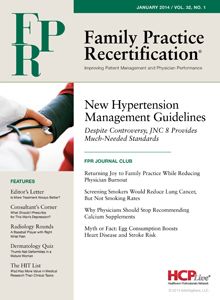Publication
Article
Family Practice Recertification
Despite Growing Literature Base, Information on HIT Use Is Stagnant
Author(s):
Although an increasing number of studies focus on health information technology (HIT), a recent review of those reports revealed many HIT components lack sufficient evidence on the effects of their implementation.

Although an increasing number of studies focus on health information technology (HIT), a recent review of those reports revealed many HIT components lack sufficient evidence on the effects of their implementation.
For their “systematic update” funded by the Office of the National Coordinator (ONC) for HIT and published in the January 2014 issue of the Annals of Internal Medicine, a team of researchers analyzed data from 236 studies on HIT use — 57% of which “evaluated clinical decision support (CDS) and computerized provider order entry (CPOE), whereas other meaningful use functionalities were rarely evaluated.” In fact, the authors discovered 12 of the 25 criteria for meaningful use — including “maintain medication allergy lists” and “capacity to track vital signs” — were not specifically assessed in any studies.
“The HIT literature is expanding rapidly but failing to produce a commensurate amount of useful knowledge,” the authors observed. “Study questions, research methods, and reporting of study details have not sufficiently adapted to meet the needs of clinicians, healthcare administrators, and health policymakers and are falling short of addressing the future needs of the healthcare system.”
Compared to 142 studies centered on CDS and 91focused on CPOE, a mere 25 studies evaluated e-prescribing, 20 reviewed patients access to electronic health records (EHR), and 10 examined patient care reminders. Nevertheless, the authors noted those less common evaluations “reported positive findings more often than not.”
Overall, 56% of the studies reported “uniformly positive results;” thus, the researchers made a broad conclusion that “CDS generally results in improvements in the processes targeted by the decision support,” and “CPOE effectively decreases medication errors.” However, they noted the studies’ “reporting of context and implementation was poor, and 61% of studies did not report any contextual details beyond basic information.”
“Insufficient reporting of implementation and context of use makes it impossible to determine why some HIT implementations are successful and others are not,” the authors concluded. “With the increasing adoption of EHR and other forms of HIT, it is no longer sufficient to ask whether HIT creates value. Going forward, the most useful studies will help us understand how to realize value from HIT.”




